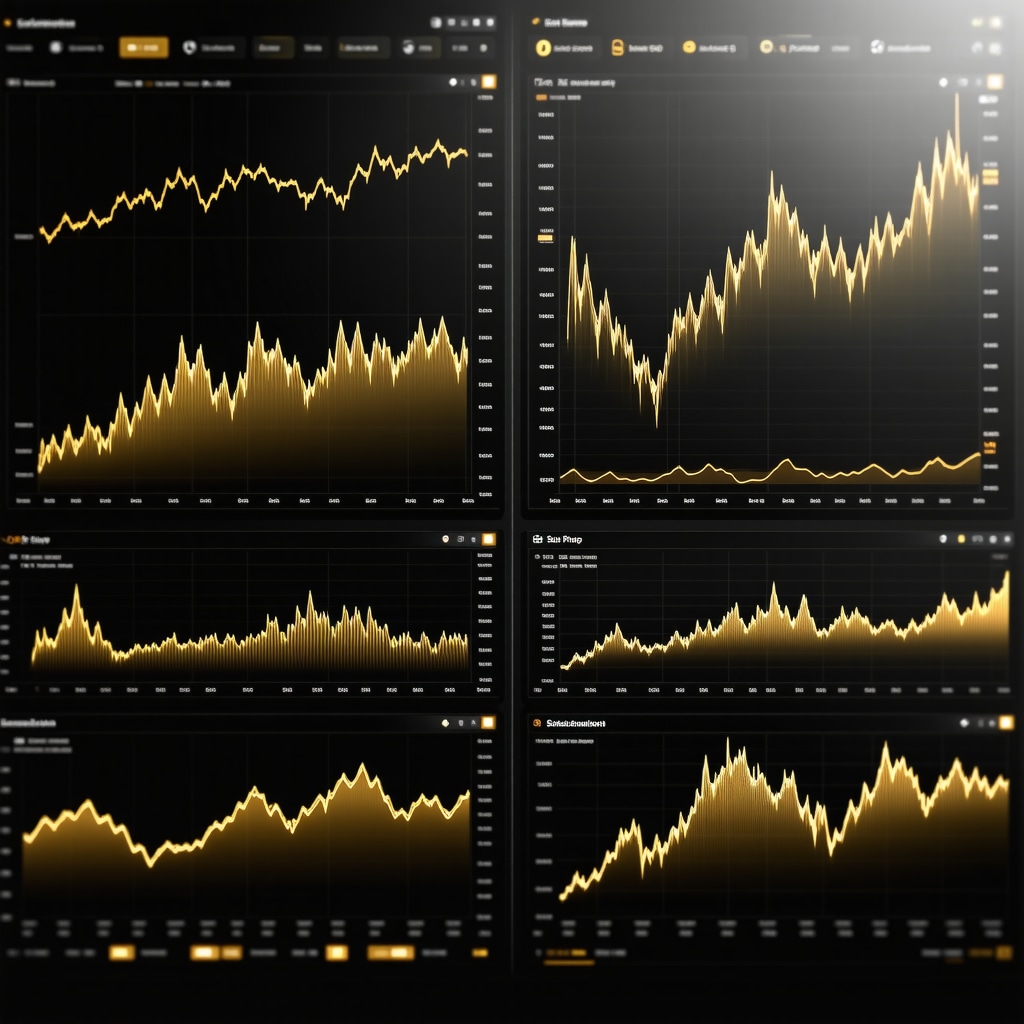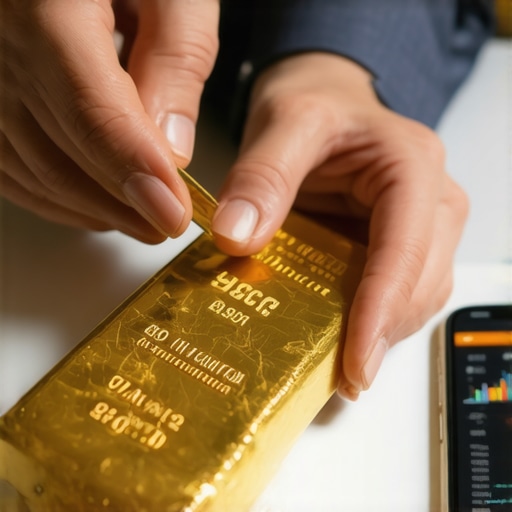Unlocking the Golden Gateway: Why Start Investing in Gold?
For beginners stepping into the investment arena, gold offers a timeless refuge against economic uncertainty and market volatility. Unlike stocks or bonds, gold carries intrinsic value, a legacy that has spanned centuries, making it a compelling starting point for those looking to diversify and stabilize their portfolios. However, diving into gold investing without guidance can be daunting. This expert guide unravels practical tips and nuanced insights to help you start your journey safely and strategically.
Decoding the Spectrum: Exploring Types of Gold Investments for New Investors
Gold investment is not a monolith; it spans physical assets like bars and coins, to financial instruments such as ETFs, mutual funds, and futures. Each type comes with unique risk profiles, liquidity considerations, and cost structures. For instance, physical gold offers tangible security but requires secure storage, whereas gold ETFs provide ease of trading with minimal storage concerns. Understanding these distinctions is crucial for tailoring your investment approach to your financial goals and risk tolerance.
How Can Beginners Safely Choose Their First Gold Investment?
Choosing your initial gold investment involves assessing authenticity, market timing, and trusted sources. Beginners should prioritize purchasing from reputable dealers with transparent pricing and certification to avoid counterfeit risks. Starting with small quantities of physical gold, such as recognized bullion coins, provides practical exposure without overwhelming capital commitment. Additionally, exploring beginner-friendly gold ETFs can diversify your holdings with lower entry barriers. For a comprehensive starting guide, consider resources like investing in physical gold for beginners.
Mastering Market Movements: Timing and Trends in Gold Investing
Gold prices are influenced by an intricate web of factors including inflation rates, geopolitical tensions, and central bank policies. New investors benefit from monitoring these macroeconomic indicators to identify optimal entry points. For example, during periods of rising inflation, gold often acts as a hedge, preserving purchasing power. Keeping abreast of authoritative market analyses, such as those provided by the World Gold Council, can sharpen your market timing and strategic decisions.
Safeguarding Your Gold: Practical Tips for Secure Buying and Storage
Safety in gold investing extends beyond purchase to include secure storage and insurance. Physical gold should be stored in high-security safes or professional vaults to mitigate theft risks. Moreover, maintaining detailed purchase records and certifications is essential for authenticity verification and resale. Beginners are advised to avoid impulsive purchases and instead follow a disciplined approach that emphasizes verification and secure handling.
Engage with Fellow Investors: Share Your Gold Investing Experiences
Starting your gold investment journey is enriched by community insights and shared experiences. We invite you to comment below with your questions, challenges, or success stories. Engaging in dialogue can provide fresh perspectives and build confidence as you navigate the golden investment landscape.
For further expert insights on physical gold investment strategies, explore this detailed guide that complements your beginner’s roadmap.
Authoritative source: World Gold Council – Gold Demand Trends
Elevating Your Gold Portfolio: Integrating Diversification and Risk Mitigation
While gold itself is a valuable diversification tool, savvy investors understand the importance of integrating gold investments within a broader, balanced portfolio. Rather than concentrating solely on physical gold or ETFs, combining various forms—such as gold stocks, mutual funds, and futures—can optimize returns and reduce vulnerability to market fluctuations. For example, gold mining stocks often provide leveraged exposure to gold price movements but come with operational risks, whereas ETFs offer liquidity and ease of access.
This multifaceted approach aligns with modern portfolio theory, which advocates for diversification across asset classes to maximize risk-adjusted returns. By blending physical bullion with financial instruments, investors can harness the unique advantages each segment offers, balancing security, liquidity, and growth potential. Beginners interested in exploring these options can find comprehensive guidance in resources like exploring types of gold investments.
Timing the Golden Wave: How Macroeconomic Indicators Signal Strategic Entry Points
Expert gold investors closely monitor economic indicators such as inflation rates, real interest rates, currency strength, and geopolitical developments to gauge gold’s potential trajectory. For instance, a decline in real interest rates typically enhances gold’s appeal as a non-yielding asset, often leading to price appreciation. Conversely, strengthening currencies or rising bond yields might dampen gold’s allure.
Furthermore, central bank policies, including quantitative easing or gold reserve purchases, create ripple effects that influence market sentiment. Staying informed through trusted sources like the World Gold Council helps investors anticipate shifts and adjust their positions accordingly.
What Are the Nuanced Risks of Combining Physical Gold and Financial Gold Instruments?
Combining physical gold and financial instruments introduces complexities that require nuanced risk management. Physical gold, while immune to counterparty risk, entails storage, insurance, and liquidity considerations. Financial instruments, such as ETFs or futures, offer higher liquidity but expose investors to market volatility, management fees, and counterparty risks.
Additionally, tax implications differ significantly between physical gold and paper gold products across jurisdictions, affecting net returns. Investors must evaluate their risk tolerance, investment horizon, and portfolio objectives before blending these assets. Engaging with expert analyses and consulting financial professionals can clarify these intricacies, ensuring an informed allocation strategy.
Leveraging Expert Insights: The Role of Authoritative Data in Gold Investing
Utilizing data from credible institutions like the World Gold Council and market analysis platforms enhances your decision-making process. These sources provide detailed breakdowns of gold demand trends, supply constraints, and geopolitical factors influencing prices.
For instance, the World Gold Council’s reports on global gold demand reveal shifts in jewelry consumption, central bank activity, and investment flows that directly impact market dynamics. Incorporating such insights allows investors to align their strategies with evolving market environments, reducing guesswork and enhancing confidence.
Engage and Expand: Share Your Journey and Discover More
Your experiences and questions enrich the gold investment community. Share your insights or seek advice in the comments below to foster a collaborative learning space. To deepen your expertise, explore our detailed guides on physical gold investments and secure buying as well as how supply changes affect gold prices. These resources offer actionable strategies for confident investing in 2025 and beyond.
Strategic Synergy: Crafting a Balanced Gold Investment Portfolio Between Physical and Financial Assets
For seasoned investors and ambitious novices alike, the art of gold investing lies not solely in choosing between physical and financial gold but in mastering their strategic synergy. Physical gold offers undeniable intrinsic security and acts as a tangible hedge against systemic risks, while financial gold instruments—such as ETFs, mining stocks, and futures—bring liquidity, leverage, and market accessibility. The challenge is designing an allocation that harmonizes these divergent attributes to achieve robust diversification and optimized risk-adjusted returns.
One advanced approach involves allocating approximately 40-60% of the gold portfolio to physical bullion or coins, ensuring a solid foundation immune to counterparty default. The remainder can be diversified among gold ETFs for liquidity and mining equities to harness leveraged upside potential. However, this blend demands continuous monitoring to rebalance exposures in response to market volatility and macroeconomic shifts.
How Can Investors Navigate the Complex Tax and Regulatory Nuances When Mixing Physical and Paper Gold?
Taxation and regulatory frameworks vary widely depending on jurisdiction and the form of gold held, often complicating portfolio strategies. Physical gold typically incurs capital gains tax upon sale, with some countries applying favorable long-term rates or exemptions for bullion coins. In contrast, gains from ETFs or mining stocks may be subject to different tax treatments, including dividend taxes and short-term capital gains.
Moreover, reporting requirements and compliance complexities increase when holding both physical and paper gold, especially in portfolios spanning multiple regions. Investors should consult with tax professionals specializing in precious metals to optimize after-tax returns and ensure adherence to local laws. This due diligence is critical to avoid unexpected tax liabilities that can erode investment gains.
Additionally, regulatory considerations such as anti-money laundering (AML) and know-your-customer (KYC) policies influence how physical gold dealers and financial platforms operate. Understanding these can prevent delays in transactions and facilitate smoother portfolio management.
Leveraging Quantitative Analytics: Predictive Models and Sentiment Analysis in Gold Market Forecasting
Beyond traditional fundamental analysis, cutting-edge investors increasingly incorporate quantitative analytics and data science techniques to anticipate gold price movements. Machine learning algorithms that analyze historical price patterns, macroeconomic indicators, and geopolitical sentiment are reshaping predictive accuracy.
Sentiment analysis, in particular, leverages natural language processing (NLP) to gauge market mood from news feeds, social media, and financial reports—providing early warning signals for volatility spikes or trend reversals. For instance, elevated geopolitical tensions extracted from real-time data streams can trigger algorithmic alerts recommending tactical allocation adjustments.
Integrating these sophisticated tools requires understanding their limitations and complementing them with expert judgment. Embracing quantitative methods can enhance decision-making precision and risk management in the inherently uncertain gold market.

What Role Does Central Bank Gold Reserves Data Play in Shaping Investor Strategies?
Central banks hold substantial gold reserves, and their buying or selling activities significantly influence market supply-demand dynamics. Detailed analysis of official reserve disclosures, often reported quarterly by institutions like the International Monetary Fund (IMF) and the World Gold Council, provides critical insights into future price trends.
For example, sustained central bank purchasing often signals confidence in gold’s safe-haven status, potentially driving prices upward. Conversely, reserve reductions might indicate shifting monetary policies or liquidity needs, exerting downward pressure. Investors who track these movements can anticipate market shifts and position their portfolios advantageously.
Incorporating central bank reserve trends into your investment thesis aligns with a macro-driven strategy that transcends short-term speculation, anchoring decisions in fundamental global monetary behaviors.
Authoritative source: World Gold Council – Gold Reserves Data and Analysis
Call to Action: Deepen Your Expertise and Elevate Your Gold Investment Strategy
Ready to transform your gold investment approach with expert strategies and data-driven insights? Dive deeper into advanced portfolio construction techniques, tax optimization, and market forecasting by exploring our exclusive series of in-depth guides and analyses. Engage with our expert community by sharing your experiences, questions, and strategies in the comments section below—collaborate to navigate the complex gold market with confidence and sophistication.
Tax Efficiency and Regulatory Navigation: Mastering Compliance in Diverse Gold Holdings
As portfolios become more sophisticated by blending physical and paper gold assets, the labyrinth of tax codes and regulatory mandates grows increasingly complex. Investors must grapple with varying capital gains treatments, VAT obligations, and reporting requirements that differ markedly across jurisdictions. For instance, while some countries exempt certain bullion coins from VAT, others impose it on gold ETFs, impacting net returns significantly. Beyond taxes, compliance with anti-money laundering (AML) and know-your-customer (KYC) regulations introduces operational layers that can affect transaction fluidity and record keeping.
Engaging specialized tax advisors familiar with precious metal investments is indispensable to architecting a tax-efficient strategy. Moreover, staying abreast of evolving legislation ensures that portfolio adjustments do not inadvertently trigger adverse tax consequences or regulatory scrutiny. This proactive compliance framework empowers investors to optimize after-tax performance and maintain seamless operational integrity.
Harnessing Machine Learning and Sentiment Analytics: The Frontier of Gold Market Forecasting
Incorporating quantitative analytics, particularly machine learning (ML) models and sentiment analysis, heralds a transformative paradigm in gold price forecasting. Advanced algorithms analyze vast datasets encompassing historical price action, macroeconomic indicators, and geopolitical narratives sourced from news and social media platforms. This fusion of data science and finance enables detection of subtle patterns and emergent trends that traditional analysis might overlook.
Sentiment analysis, leveraging natural language processing (NLP), quantifies market mood and investor psychology, providing anticipatory signals ahead of volatility spikes or trend reversals. For example, an uptick in negative geopolitical sentiment detected through NLP can preemptively inform defensive positioning. Nevertheless, these models require expert calibration and interpretation to account for false positives and market anomalies, underscoring the necessity to complement quantitative insights with seasoned judgment.
How Can Investors Integrate Central Bank Gold Reserve Trends into Tactical Portfolio Decisions?
Central banks’ accumulation or divestment of gold reserves is a pivotal barometer of macroeconomic confidence and monetary policy direction. Detailed tracking of these official holdings, facilitated by authoritative sources such as the World Gold Council’s Gold Reserves Data and Analysis, equips investors to anticipate supply-demand shifts with greater precision.
For instance, sustained central bank purchasing often signals an intent to diversify away from fiat currencies, bolstering gold’s safe-haven appeal and potentially catalyzing price appreciation. Conversely, reserve reductions may reflect liquidity needs or changing policy priorities, exerting downward pressure. Tactical portfolio adjustments aligned with these signals can enhance risk-adjusted returns by positioning ahead of broader market movements.

Call to Action: Engage with Cutting-Edge Gold Investment Insights
Elevate your investment acumen by embracing these advanced strategies and analytics. Explore further the intersection of tax optimization, quantitative forecasting, and central bank monitoring through our comprehensive resources. Join our expert community by sharing your questions and experiences below—unlock sophisticated tactics that empower you to master the dynamic gold market with confidence and precision.
Frequently Asked Questions (FAQ)
What is the safest way for beginners to start investing in gold?
Beginners should start with small purchases of physical gold such as certified bullion coins from reputable dealers or low-cost gold ETFs. Physical gold provides tangible security, but ETFs offer liquidity and ease of access. Always verify authenticity and consider secure storage options to minimize risks.
How do gold ETFs differ from physical gold investments?
Gold ETFs represent ownership in gold-backed financial instruments traded on exchanges, providing liquidity and lower storage costs. Physical gold requires secure storage and insurance but offers direct ownership without counterparty risk. The choice depends on your investment goals and risk tolerance.
What macroeconomic indicators should I monitor to time gold investments?
Key indicators include inflation rates, real interest rates, currency strength, and geopolitical developments. Rising inflation and declining real interest rates often increase gold’s appeal. Monitoring central bank policies and gold reserve purchases also helps anticipate price movements.
What are the risks associated with mixing physical gold and financial gold instruments?
Mixing assets adds complexity: physical gold requires secure storage and has liquidity constraints, while financial instruments expose you to counterparty risk, market volatility, and management fees. Tax treatments and regulatory compliance also differ and must be carefully managed.
How do tax regulations impact gold investments?
Tax treatments vary widely by jurisdiction and asset type. Physical gold may be subject to capital gains tax with some exemptions, while ETFs and gold stocks can incur dividend and short-term gains taxes. Consulting tax professionals knowledgeable in precious metals is essential to optimize after-tax returns.
Can machine learning and sentiment analysis improve gold market forecasts?
Yes, advanced algorithms analyze historical data and market sentiment from news and social media to detect patterns and potential price movements. However, these tools should complement expert judgment due to possible false signals and market anomalies.
How do central bank gold reserve trends influence investor strategies?
Central bank purchases often indicate confidence in gold, potentially driving prices up, while sales may signal liquidity needs and downward pressure. Tracking these trends via authoritative sources allows investors to position portfolios proactively in line with macroeconomic shifts.
What storage options are recommended for physical gold?
High-security home safes, professional vault storage, or insured depositories are preferred. Each option balances security, accessibility, and cost. Maintaining detailed records and certifications is crucial for authenticity and resale value.
How can investors balance liquidity and security in gold portfolios?
Combining physical gold (40-60%) with financial instruments like ETFs and mining stocks provides a blend of tangible security and market liquidity. Regular portfolio rebalancing and risk assessment help maintain this strategic balance aligned with investment objectives.
What role do regulations like AML and KYC play in gold investing?
AML and KYC regulations ensure transaction transparency and prevent illicit activities. Compliance affects how dealers and platforms operate, influencing transaction speed and record keeping. Understanding these regulations helps avoid delays and maintain portfolio integrity.
Trusted External Sources
- World Gold Council (https://www.gold.org/): The premier authority on gold market data, demand trends, and central bank reserve analysis, offering comprehensive research that underpins informed investment strategies.
- International Monetary Fund (IMF) Gold Reserves Data (https://www.imf.org/): Provides official statistics on central bank gold holdings, critical for analyzing macroeconomic impacts on gold supply and pricing.
- London Bullion Market Association (LBMA) (https://www.lbma.org.uk/): A key industry body offering standards for gold trading, certification of bullion, and market transparency essential for secure physical gold transactions.
- Financial Times and Bloomberg Commodities Sections: Renowned for up-to-date market analysis, geopolitical insights, and expert commentary vital for tracking gold market movements.
- Academic Journals such as Journal of Commodity Markets: Deliver rigorous research on gold’s role in portfolio diversification, risk management, and price forecasting methodologies including quantitative models.
Conclusion
Gold investing remains a cornerstone strategy for portfolio diversification and economic uncertainty hedging. This expert guide has elucidated the multifaceted nature of gold investments—from physical bullion and ETFs to mining stocks and futures—highlighting the importance of blending these assets to balance security, liquidity, and growth potential. By monitoring macroeconomic indicators, leveraging authoritative data from trusted institutions, and incorporating advanced analytics such as machine learning and sentiment analysis, investors can refine timing and strategy with greater precision.
Moreover, navigating tax and regulatory frameworks with professional guidance ensures optimized after-tax returns and compliance integrity. Secure storage and authenticity verification safeguard physical holdings, while understanding risks associated with financial gold instruments prevents unforeseen losses.
Embracing these comprehensive insights empowers both beginners and seasoned investors to craft resilient, sophisticated gold portfolios aligned with their financial goals. We encourage you to share your experiences, pose questions, and delve deeper into related expert resources to elevate your gold investment journey.
Explore, engage, and apply these expert strategies to unlock the full potential of gold investing today.











As someone who’s recently started exploring gold investments, I found this post’s focus on the different types of gold investments really insightful. The distinction between physical gold and financial instruments like ETFs was particularly valuable, especially the reminder about storage and authenticity concerns with physical gold. In my own experience, starting with a small amount of certified bullion coins gave me a tangible sense of security and helped build my confidence before considering ETFs. I also appreciate the emphasis on monitoring macroeconomic indicators—I’ve noticed how inflation trends have affected gold prices, and keeping an eye on central bank actions adds another layer of understanding.
One challenge I’ve faced is balancing the liquidity benefits of ETFs with the security of physical gold. Has anyone developed a strategy or preferred ratio for blending these two forms that aligns well with risk tolerance and investment goals? How do you manage the practical aspects like storage costs or tax implications in your portfolio? I’d love to hear how more seasoned investors handle these nuances to maintain both accessibility and safety in their gold holdings.